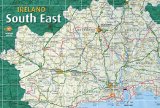South East Ireland Tourism
Travel guide to Ireland's south east
Travel guide to Ireland's south east
Christian History of Waterford
Waterford is in the Diocese of Waterford & Lismore and as is the case of most Irish dioceses, the origins of the Church in the Diocese of Waterford and Lismore are mainly monastic. In the early twelfth century, when the diocesan system was coming into being, there were three ecclesiastical centres that laid claim to diocesan status: Ardmore, Lismore and Waterford. Ardmore and Lismore had monastic ancestry; Waterford had not. Since Viking times, Waterford had become a Danish settlement and was gradually becoming Christian. The mercantile status of Waterford was second only to Dublin and, towards the end of the eleventh century; the time seemed ripe for it to seek increased ecclesiastical importance. So a petition was sent to the Archbishop of Canterbury that a monk from Winchester be consecrated Bishop for the community of Waterford. The year was 1096 and the first bishop was Malchus or, to give him his Gaelic name, Mael Isu Ua hAinmire.
And so, when the diocesan system came to be established at the Synods of Rathbreasail (1111) and Kells (1152), there were three claimants for diocesan status from the Deise region. At Kells, all three were established as dioceses. Ardmore was recognised a a diocese with its own bishop until about 1210, when it seems to have become subsumed into Lismore. The individual dioceses of Waterford and of Lismore went their separate ways until 1363, when the Bishop of Waterford, Roger Craddock, was transferred to Llandaff in Wales, and Robert le Reve of Lismore became the first Bishop of Waterford and Lismore. And so the situation has remained ever since.
A key figure in Waterford’s Christian history is Edmund Rice who set up his first school for poor boys in Waterford City in 1802 in New Street. This school was eventually re-located to Mount Sion on Barracks Street where there is still a school in existence today. In 1808, Edmund Rice along with six of his companions dedicated himself to vow to God’s service which was the beginning of the Presentation Monasteries and Presentation Brothers. Edmund’s vision was to open schools ‘in all parts of the kingdom’ and between 1802 and 1820 schools were opened in Waterford, Carrick-on-Suir, Dungarvan, Cork, Dublin, Cappoquin, Limerick and Thurles. In 1820, Pope Pius VII approved the rule of the Religious Brothers. The Presentation Brothers were the first to open schools outside Europe in India and the United States. Today the Presentation Brothers live and work in Ireland, England, Canada, the United States of America, Peru, the West Indies and Ghana. The remains of Blessed Edmund Rice are housed in the Edmund Rice Heritage Centre on Barrack Street, Waterford.
Luke Wadding was born on October 16 th 1588 in Waterford to Walter Wadding of Waterford, a wealthy merchant and his wife Anastasia who was a sister of Peter Lombard, Archbishop of Armagh and Primate of Ireland. Wadding became a Franciscan in 1607 and was ordained a priest in 1613. He collected funds for the establishment of the Irish College at St Isidore in Rome for the education of Irish priests which opened in 1625. He was an enthusiastic supporter of the Irish Catholics and his college became the strongest advocate of the Irish cause in Rome. It is through Luke Wadding’s efforts that St Patrick’s Day became a feast day in Ireland.
There are a number of ecclesiastical landmarks in Waterford City which it is recommended that you visit including St Patrick’s Churches, Black Friars, St Olaf’s Church, Greyfriars, Christ Church Cathedral and the Cathedral of the Most Holy Trinity.
<< Return to Waterford History
And so, when the diocesan system came to be established at the Synods of Rathbreasail (1111) and Kells (1152), there were three claimants for diocesan status from the Deise region. At Kells, all three were established as dioceses. Ardmore was recognised a a diocese with its own bishop until about 1210, when it seems to have become subsumed into Lismore. The individual dioceses of Waterford and of Lismore went their separate ways until 1363, when the Bishop of Waterford, Roger Craddock, was transferred to Llandaff in Wales, and Robert le Reve of Lismore became the first Bishop of Waterford and Lismore. And so the situation has remained ever since.
A key figure in Waterford’s Christian history is Edmund Rice who set up his first school for poor boys in Waterford City in 1802 in New Street. This school was eventually re-located to Mount Sion on Barracks Street where there is still a school in existence today. In 1808, Edmund Rice along with six of his companions dedicated himself to vow to God’s service which was the beginning of the Presentation Monasteries and Presentation Brothers. Edmund’s vision was to open schools ‘in all parts of the kingdom’ and between 1802 and 1820 schools were opened in Waterford, Carrick-on-Suir, Dungarvan, Cork, Dublin, Cappoquin, Limerick and Thurles. In 1820, Pope Pius VII approved the rule of the Religious Brothers. The Presentation Brothers were the first to open schools outside Europe in India and the United States. Today the Presentation Brothers live and work in Ireland, England, Canada, the United States of America, Peru, the West Indies and Ghana. The remains of Blessed Edmund Rice are housed in the Edmund Rice Heritage Centre on Barrack Street, Waterford.
Luke Wadding was born on October 16 th 1588 in Waterford to Walter Wadding of Waterford, a wealthy merchant and his wife Anastasia who was a sister of Peter Lombard, Archbishop of Armagh and Primate of Ireland. Wadding became a Franciscan in 1607 and was ordained a priest in 1613. He collected funds for the establishment of the Irish College at St Isidore in Rome for the education of Irish priests which opened in 1625. He was an enthusiastic supporter of the Irish Catholics and his college became the strongest advocate of the Irish cause in Rome. It is through Luke Wadding’s efforts that St Patrick’s Day became a feast day in Ireland.
There are a number of ecclesiastical landmarks in Waterford City which it is recommended that you visit including St Patrick’s Churches, Black Friars, St Olaf’s Church, Greyfriars, Christ Church Cathedral and the Cathedral of the Most Holy Trinity.
<< Return to Waterford History






